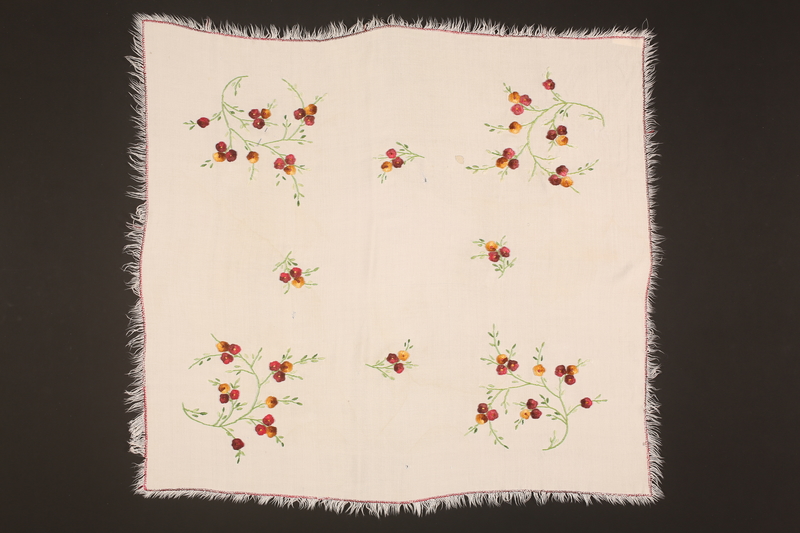Masza Senderowski was born on May 5, 1927, in Djatlova (Zdziecol), Poland (Dziatlava, Belarus), near Nowogrodek, to Jewish parents, Jakub, a butcher, and Mina Orlinski Senderowski. Masza had three sisters: Lea, born in 1921; Frieda, born in 1924, and Sonia, born in 1929. All four girls attended the Tarbut school and belonged to Betar, a Zionist youth organization. In September 1939, Nazi Germany invaded Poland. A few weeks later, the Soviet Union invaded from the east. The Senderowski’s lived in the Soviet occupied eastern region. The school was closed and Jewish organizations were abolished. Masza attended a Soviet school. In June 1941, Germany invaded the Soviet Union and occupied Zdziecol. Approximately 3,000 Jews lived in the town and, in the fall of 1941, they were forced into a ghetto, which was surrounded by a barbed wire fence. The Senderowski house was within the ghetto, but they now shared it with eighteen additional people. Mina immediately prepared two hiding places in the house: one behind a false wall, masked by a heavy credenza, and the other, a dugout under the house.
On August 6, 1942, the Germans began to empty the ghetto. The Jewish residents were ordered to come to the market place and lay on the ground. Masza and her two older sisters decided to run and were shot at by the guards. The girls tried to hide in the house of a Christian neighbor, but he called the Gestapo, who took the girls back to town. As they were being taken back to town, Masza somehow found herself alone. She reached her house, and hid in the secret space behind the false wall. Some neighbors, Mr. and Mrs. Zuchowicki and their son, Srulik, 14, were already there. During the next two or three days, Masza heard gunshots and screams from the market place. When it became quiet they decided to move to the second hiding place in the cellar. There were other Jews already hiding there, and they crowded four adults and three children into the dugout. There was no light, food, or water, or sanitary facilities. As they hid there for several days, Masza could hear their Polish neighbors coming into the house and taking their belongings. One night, she and the others decided to leave and try to reach the forest. Masza remembers a complete silence, even the ever present crows were quiet. After reaching the forest, they sought the partisans known to live there. Masza and Srulik Zuchowicki became separated from his parents. The two 14year olds walked all night. In the morning, they realized that they were walking around mass graves where the Jews from their town had been shot. They wandered a few days and encountered a Soviet partisan group, but they were rejected. Masza began walking with a solitary girl, Itka. The forest was very cold at night and they had no food. At one point, they were able to exchange Irka’s gold ring for two loaves of bread. They lived this nomadic life for about two and a half years until ,by chance, they encountered Masza’s father, who had escaped from the Nowogrodek ghetto. Later, they also found her mother. Masza learned that her younger sister Sonia was killed during the aktion where she escaped. They never learned what happened to her sisters Lea and Frieda, tohugh it is pesumed they were killed during that 1941 selection.
In the summer of 1944, the Soviet Army liberated the Djatlovo area. Masza returned to her village. Accompanied by a Soviet Jewish soldier, she went into a non-Jewish neighbor’s house where she found many of the objects stolen from her family home. She retrieved two doilies, one embroidered by her younger sister, with her initials "S.S" (Sonia Senderowicz) in Hebrew and the other embroidered by one of her older sisters. The war in Europe ended in early May 1945. In July, Masza and her parents left Byelorussia, travelled through Bialystok, and continued to Łódź, Poland. After six months, they left Poland illegally for Berlin and later for Munich. They stayed for a short time in Heidenheim displaced persons camp, near Stuttgart. In May 1949, Masza sailed to New York on board the General Taylor. Her parents joined her in 1950. Masza married Leon Koncopolski, a survivor from Baranowicze and they had two daughters. In 1957, Masza divorced Leon. She married Will Taplin, who passed away in 1983.




